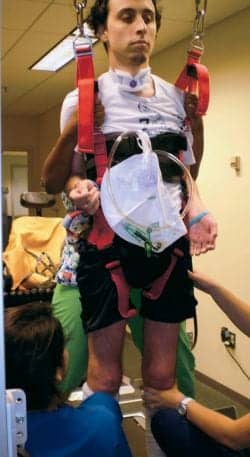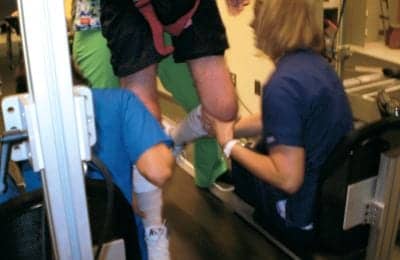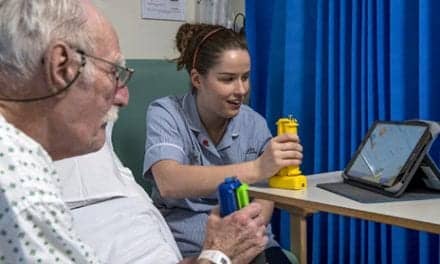
A 24-year-old inpatient with C6 ASIA impairment scale A tetraplegia utilizing the body-weight support device for dynamic standing and stepping.
People who have sustained a catastrophic injury or disability come to rehabilitation with a number of goals and benchmarks for their recovery. One of the most common goals for both children and adults in this situation is also one of the most basic: “I want to get back on my feet.” Whether they have a spinal cord injury, multiple sclerosis, stroke, brain injury, or developmental disorder, standing can be an important achievement on the road to recovery. Standing frames or other standing devices are excellent tools to facilitate this goal.
These devices also may be used to promote general physiological well-being and for prevention of secondary complications. The article “The Need to Stand,” published in Rehab Management’s January 2010 issue, reviews the basic uses and benefits of traditional standing devices. Since 2010, there has been significant progress in neurologic rehabilitation technology, specifically in the development of more dynamic standing devices, and this article highlights some of these new technologies. Traditional devices, such as standing frames, tilt tables, and standing wheelchairs, can effectively facilitate weight bearing and upright positioning for many individuals. These devices continue to be very useful modalities in both clinical and home settings. For today’s rehabilitation professional, the question is no longer how to get individuals in a standing position, but rather how to challenge them further in standing to facilitate recovery and independence for individuals of all injury levels. Some examples of these emerging dynamic systems include body-weight support devices, FES steppers, and a variety of robotic exoskeletons. These modalities are no longer just for people trying to improve their walking pattern and independence. The benefits of these dynamic systems can apply to almost anyone with a neurologic injury or disease at any age or stage of recovery.
In general, standing devices can effectively improve standing ability in a number of ways. Dependently positioning individuals in standing provides lower extremity weight bearing, giving the body proprioceptive and tactile input that can activate antigravity musculature while inhibiting competing muscle spasticity. For example, a child with cerebral palsy may utilize a tilt table to inhibit excessive spasticity in order to functionally use their upper extremities. This weight-bearing input also can improve an individual’s symmetrical limb activation, midline orientation, trunk activation, head control, and functional upper extremity use. This could be beneficial for people with poststroke “pusher’s syndrome” who may not weight bear equally through their lower extremities and could have an altered sense of vertical. Standing devices can promote increased weight bearing through the hemiplegic side and, therefore, improve midline orientation and symmetrical lower extremity activation in preparation for independent standing or ambulation.
For those individuals who do not have independent standing or ambulation as a primary goal, standing devices still may be utilized and can have multiple varied physiological benefits. For example, an individual with complete spinal cord injury may not have independent standing as a realistic short-term goal, but still may be participating in a standing program. The physiological benefits of standing for all individuals include improved renal function, promotion of digestion/bowel function, increased bone density, promotion of normal hip joint development in the pediatric population, contracture management and prevention, spasticity management, reduced incidence of orthostatic hypotension, improved skin integrity, improved respiratory capacity and efficiency, and psychosocial well-being. Psychosocial well-being, though to some may appear to be a secondary focus, is an essential piece of the overall well-being of an individual and a key component of any rehab program. For both children and adults, the ability to interact with peers at a standing level can lead to improvements in self-esteem, self-image, and motivation—and these factors can make more of an impact in a person’s progression through rehab than many other tangibles.
Another common modality that facilitates standing and weight bearing is a body-weight support system. These systems, which are more dynamic than other similar modalities, can be used either over ground or over a treadmill. The individual is supported by a harness through the pelvis and trunk, and the amount of weight or loading can be customized depending on the individual’s strength and ability level. This system challenges any active lower extremity, trunk, or upper extremity control, and may compound the benefits of standing. Additionally, this system allows individuals to safely perform many other dynamic balance and pregait activities that would be impossible in a static standing device, such as a standing frame. For example, individuals utilizing body-weight support systems are able to shift their weight onto each lower extremity with feet side by side or in stride stance, perform squats or lunges, execute trunk movements in all planes of motion, or reach an upper extremity outside their base of support.

The goal of rehab professionals is to get people up on their feet, no matter what age, ability level, or type of injury.
Body-weight support systems are a main component of locomotor training, a therapeutic intervention originally designed to retrain the nervous system how to walk. There are two main categories of locomotor training: robotic and manual. Both types of training allow the therapist to vary the amount of body-weight support provided, the level of assist provided, and the speed of stepping. Initially, this modality was thought to be beneficial only for people whose primary goal was functional ambulation; however, more and more research and clinical findings are showing functional, health, and psychological benefits for people of all injury and ability levels. For example, an individual with a C6 complete spinal cord injury may participate in locomotor training to improve upright tolerance, enhance head and trunk control and strength for increased independence with transfers or bed mobility, develop cardiovascular endurance, and/or maximize loading through the lower extremities. Alternatively, an individual with a C6 incomplete spinal cord injury with emerging movement may have goals of standing or ambulating over ground in addition to the goals mentioned above.
Locomotor training is used in both inpatient and outpatient rehabilitation. Inpatient facilities are comprehensive, meaning insurance companies pay a determined amount for a person’s entire stay and locomotor training is billed as physical therapy. Similarly, in an outpatient clinic, locomotor training is billed as any other physical therapy service and uses the same CPT codes; however, outpatient reimbursement is specific to each client’s payor. Once a patient has progressed enough in their rehab to no longer require formal physical therapy services, they may have the option to continue with locomotor training through many facilities’ wellness programs where a person can privately pay to use the modality.
The use of functional electrical stimulation (FES) is gaining popularity in rehabilitation. FES is a technique that uses electrical currents to activate nerves, innervating extremities affected by paralysis. Several studies support the use of FES in combination with body-weight supported treadmill training. Last year, the first system was introduced to combine the use of FES with a body-weight supported system to facilitate standing and stepping activities. The system uses FES to stimulate nerves that activate core and leg muscles to produce a stepping pattern and/or perform standing activities. This is different from the locomotor training systems in that the use of FES enables a person’s paralyzed or weak legs to move through a functional pattern using their own muscles. There are both adult and pediatric versions of this system.
Finally, some of the latest standing technology in the realm of neurologic rehabilitation is centered on the development of robotic exoskeletons. Currently, these devices are being used primarily for people with paraplegia. Although many individuals with different mobility-limiting diagnoses may benefit from this technology, at this time the spinal cord injury population offers funding and investment sources the most attractive and dramatic benefits. Currently, most exoskeletons are being used therapeutically in rehabilitation hospitals and outpatient clinics. A few companies are beginning to sell their exoskeletons commercially; however, the cost is currently upwards of $100,000. The challenge is to make a more affordable model that will enable people with spinal cord injuries and other neurologic diagnoses to utilize these exoskeletons functionally outside of hospitals and clinics. While the functional, psychological, and health benefits of these devices are known, their ability to facilitate motor recovery has yet to be determined.
In terms of pediatric options for standing devices, much of the technology is still being modified to accommodate smaller body frames. Both robotic and manual locomotor training systems have pediatric models, and a pediatric version of the FES stepper system is available; however, the systems can accommodate only a limited height range. Currently, the robotic exoskeletons are only built to fit individuals ranging from approximately 5 foot 2 inches to 6 foot 2 inches.
To participate in weight bearing and standing at home, the most economical and feasible methods are still the different types of standing frames and other devices; however, an increasing number of inpatient, outpatient, and wellness centers are investing in technologically advanced dynamic standing systems. In the future, the challenge will remain in convincing insurance companies of the long-term benefits in terms of overall wellness for those with less chance of becoming a functional ambulator. Despite the financial challenges, the goal of all rehabilitation professionals is to get people up on their feet as soon and as often as possible, no matter what age, ability level, or type of injury.
Erin O’Donnell, PT, DPT, NCS, is a senior therapist at Magee Rehabilitation Hospital in Philadelphia, where she has spent the last 2 years working on the spinal cord injury unit. She also helps run the inpatient and outpatient locomotor training program at Magee.
Lindsay Silver, PT, DPT, has worked as a physical therapist in inpatient neurorehabilitation throughout her career, at Kessler Institute for Rehabilitation in West Orange, NJ, and Magee Rehabilitation Hospital. Her clinical experience includes working with patients of all ages with spinal cord injury, stroke, brain injury, and other neurological conditions. She specializes in wound care. For more information, contact .
Bibliography
- Adams MM, Hicks AL. Comparison of the effects of body-weight supported treadmill training and tilt table standing on spasticity of individuals with chronic spinal cord injury. J Spinal Cord Med. 2011;34(5):488-494.
- Edwards LC, Layne CS. Effect of dynamic weight bearing on neuromuscular activation after spinal cord injury. Am J Phys Med Rehabil. 2007;86:499-506.
- Gorgey AS, Poarch H, Harnish A, Miller JM, Dolbow D, Gater DR. Acute effects of locomotor training on neuromuscular and metabolic profile after incomplete spinal cord injury. NeuroRehabilitation. 2011;29(1):79-83
- Harkema S, Behrman A, Barbeau H. Locomotor Training: Principles and Practice. New York: Oxford University Press USA; 2011.
- Huston G. Use of prolonged standing for individuals with spinal cord injuries. Phys Ther. 2001;81:1392-1399.
- Israel JF, Hornby T. Physiological responses of individuals with spinal cord injury during robotic-assisted treadmill walking. J Neurol Phys Ther. 2005;29(4):210.
- Jack LP, Purcell M, Allan DB, Hunt KJ. Comparison of peak cardiopulmonary performance parameters during robotics assisted treadmill exercise and arm crank ergometry in incomplete spinal cord injury. Technol Health Care. 2010;18:285-296.
- Jacobs PL, Johnson B, Mahoney ET. Physiologic responses to electrically assisted and frame-supported standing in persons with paraplegia. J Spinal Cord Med. 2003;26(4):384-389.
- Macias LM. The effects of the standing programs with abduction for children with spastic diplegia. Pediatr Phys Ther. 2005;17:96.
- Tremblay F, Malouin F, Richards CL, Dumas F. Effects of prolonged muscle stretch on reflex and voluntary muscle activations in children with spastic cerebral palsy. Scand J Rehabil Med. 1990;22:171-180.
- Walter JS, Sola PG, Sacks J, Lucero Y, Langbein E, Weaver F. Indications for a home standing program for individuals with spinal cord injury. J Spinal Cord Med. 1999;22:152-158.





